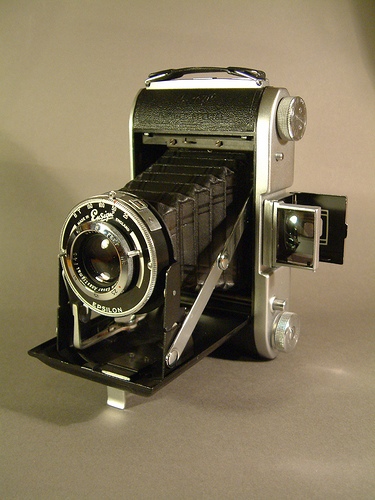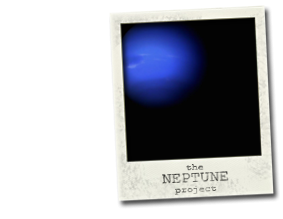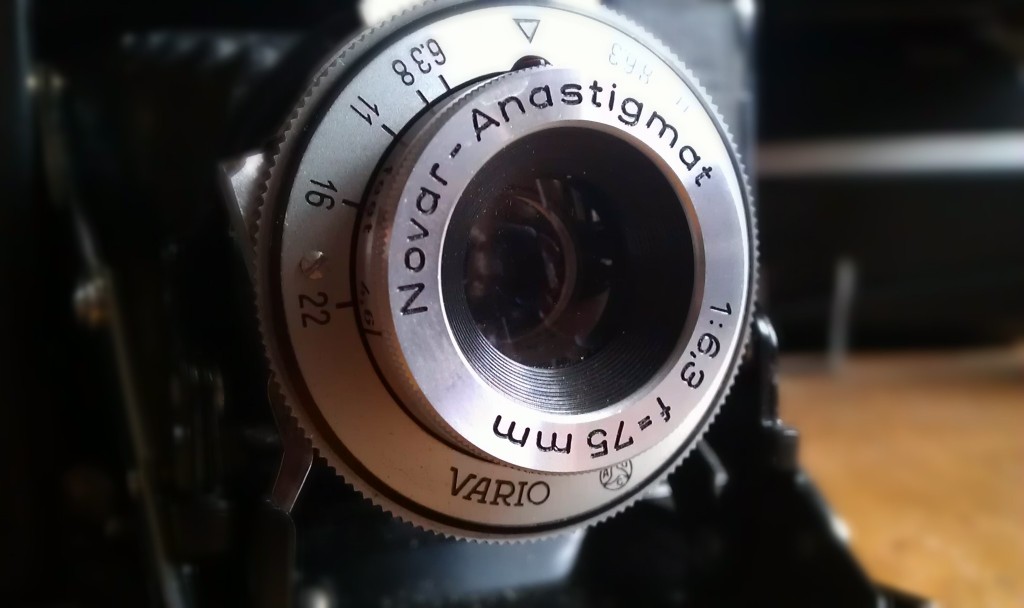 Today I have listed the Zeiss Ikon Nettar folder on Ebay. I have got to the stage where I cannot reasonably buy any more cameras without losing a few and since we have three other folders in the house, all of which have more appealing attributes than this, the Zeiss is leaving. There’s Alice’s Ensign Ranger, which is of somewhat better quality, and my Voigtlander Bessa, which is of much higher quality, and then there is Alice’s Kodak Vest Pocket, which dates from the first world war. You can see why the Nettar was chosen as the sacrifice.
Today I have listed the Zeiss Ikon Nettar folder on Ebay. I have got to the stage where I cannot reasonably buy any more cameras without losing a few and since we have three other folders in the house, all of which have more appealing attributes than this, the Zeiss is leaving. There’s Alice’s Ensign Ranger, which is of somewhat better quality, and my Voigtlander Bessa, which is of much higher quality, and then there is Alice’s Kodak Vest Pocket, which dates from the first world war. You can see why the Nettar was chosen as the sacrifice.

Norwich Cathedral cloisters
It is always painful to part with a camera, even if you believe that you’re unlikely to use it again, and this particular camera got some pleasing results, despite its very old, and incredibly slow, lens. It is still beautifully made and if you are patient with it, this folder is capable of getting good results. This photo of the beautiful cloisters at Norwich Cathedral was taken with it.
I am also fixing up another Voigtlander, this a ‘Brilliant’ TLR, which was the template from which the Lubitel was forged. In fact, the Lubitel 2 is a near identical copy of the Brilliant, but made with an intriguing hotch-potch of cheaper materials and more current technologies. The mirror had lost most of its silvering and some of the screws holding the waist-level finder in place were rusted through. I gave the camera a thorough clean and service yesterday and today I bought a glass cutter and a cheap make-up mirror and I’ll cut a new lens mirror for it and that should make it as good as new, which is no mean feat for a camera that is 80 years old.
We spent yesterday on a ‘field trip’ in the nearby environs of Rockland Saint Mary – in the heart of the Norfolk Broads. It’s a really beautiful part of the country, I went on a holiday there for a week with some friends when I was younger and we had a fantastic time fishing for eels and frying them up for breakfast on the boat stove. It was a rather wild and unkempt place back then.
Going back there yesterday, I was initially taken aback by how much it had changed. It seemed that every hedge was neatly trimmed, all the grass verges were mowed to a regulation length, and all the paths were properly edged and signposted. All trace of the splendid wilderness of 20 years ago seemed to have vanished.
Maybe this is just a reflection of our times, it seems to me that there is no delapidation, ruin or decay allowed in the world anymore and everyone works very hard to turn our great wildernesses into golf courses. Why would that be? The world is losing its character in this way, and one place looks much the same as any other. The English countryside is becoming uniformly twee.
Even so, there were some beautiful sights and sweeping vistas. I went out with the two mamiyas – the 645 and the 330 – and hopefully there will be some pleasing results after our long day’s walking. I must add that the photography seemed to flow better after our halfway stop at a riverside pub. Neptune loves company!
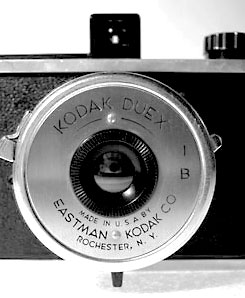 Yesterday I spotted an old boxed camera on the top shelf of my study. Okay, it’s not so much a study, as a space under the stairs which nobody else is interested in, but there are shelves there and a desk, so it’s a kind of study. The camera is a Kodak Duex, which is just one consonant short of unfortunate. It is a very funny camera, made in 1940, takes 620 film and has no options at all! This is even more point and click than the camera on my phone, which needs to be fired up before I can use it.
Yesterday I spotted an old boxed camera on the top shelf of my study. Okay, it’s not so much a study, as a space under the stairs which nobody else is interested in, but there are shelves there and a desk, so it’s a kind of study. The camera is a Kodak Duex, which is just one consonant short of unfortunate. It is a very funny camera, made in 1940, takes 620 film and has no options at all! This is even more point and click than the camera on my phone, which needs to be fired up before I can use it.
The body is Bakelite and the lens spirals out from the camera body, giving the correct focusing distance from the lens to the film surface. The shutter fires at a very shake-inducing 1/30th of a second, so I am not sure it will be easy to use at all. Anyhow, I’d left this camera in its box for a few months without realising that I had already put some film in it! I have a lot of work to do today, but when I’ve got through some of that I shall go out for a walk and see how it goes.
Today I finished posting all the galleries I’m going to be putting up here. I count 13 altogether, which means that I’ve processed film from 13 different cameras, which are listed in a vague chronological order of manufacture, from the Zeiss Ikon Nettar (the 517/16) made in 1949, to the Canon EOS 5, manufactured in the mid 1990′s. I have used older cameras – like for example the Voigtlander Bessa of 1937 which requires a light-leak fix before I can safely publish any photos – and eventually I hope to get a turn of the (20th) century plate camera to really get a feel for the beginnings of photography.
I am also getting to the stage where I’m beginning to settle on a couple of cameras for various applications. I really enjoyed using the Olympus 35 SP for a walkabout camera, even though my copy was cranky as hell and didn’t have a functioning spot-meter. I love the Zorki for the same reasons, so although I still believe the Canon A-1 is the perfect all-rounder I’m not sure I am going to be taking too many more shots with it, for a while at least. I do have a roll of infrared I want to put through it, but other than that I think I will get a decent rangefinder for general use. I might go with the Olympus, or perhaps a Nikon S2 or some other similar Leica style.
I also appreciate the style of the Halina 35x and too the Ilford Sprite so I’m very happy to continue using old, odd cameras whenever I can find one. The Hunter-Gilbert was a real surprise and it only cost me £3 on Ebay. For the future I have film loaded into a Kodak Instamatic (from 1976) and an Argus C3 Rangefinder, the camera which popularised photography in the USA. There’s nothing like moving through the history of photography in this way, you really begin to understand how the art and science of cameras evolved over time. When you pick up a rangefinder you really appreciate the technology that allows you to focus the camera without moving yourself or your subject to fit the readings on the lens barrel. And as for exposure meters!
There is something quite magical though about a camera which only has one or two shutter settings and no means of focusing except a very narrow aperture! You have to work with the camera, understand it and what it needs and then it makes no difference how out of date the thing is, it will still take a beautiful picture.
My first cross-processed film.
We bought some Fujicolor C200 from Bulgaria, on eBay, and I processed the film in Ilford LC29 (black and white) chemicals. This gallery contains some of the shots from that roll. I was pleasantly surprised by the results. 
ddd
My first cross-processed film. We bought some Fujicolor C200 from Eastern Europe, on eBay, and I processed the film in Ilford LC29 chemicals. This gallery contains some of the shots from that roll. I was pleasantly surprised by the results.
Just had a totally magical experience.
Yesterday, I developed a film with some trepidation. I had brought it with me, in my camera, before Jem and I were together.
I wasn’t sure what would be on it.
As
it was, the Universe fixed that problem for me. As I spooled it in the
dark bag, it was horribly stuck together and my heart began to sink.
As I went through the developing process, more bits of film disintegrated away with each chemical emptied out of the tank.
I
took it out of the tank and there was nothing left. Just scraps of what
once was film on the long plastic reel. I hung it out to dry thinking
at the very least we could use the film to teach the boys how to wind it
onto a spool.
Then, today, just before either ditching it or putting it away, I looked closer and saw a little face.
Only two partial prints had survived. Both of a baby Bert (of whom I now own precious few photographs).
And here he is…
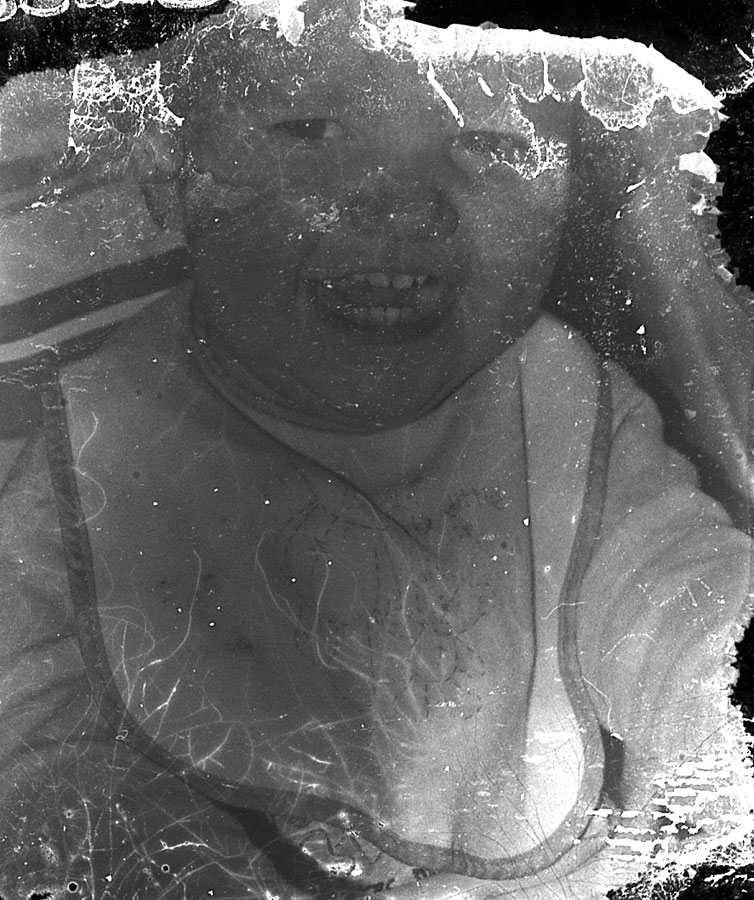
Today I am going to process three films, a roll of Neopan 1600 (from the Canon A1), a roll of TRI-X (from a Zenit TTL) and some HP5 (from the Lubitel 166). Yesterday I cross-processed some XP2 from my Mamiya C330 and a roll of BW400 from an Olympus 35 SP.
It’s all go here in the midwest Norfolk home darkroom!!
I have just processed a roll of expired Ilford XP2 in LC29 chemicals and the negative strip is pink. Yes, bright, wonderful pink. The pictures look good though, they were taken on a Mamiya C330 TLR.
Yesterday I developed my first ever roll of film from this extremely handsome folding camera. The results were very mixed, from the downright abstract to the breathtakingly timeless.
One aspect that made me laugh out loud, though, was the wonkiness of several shots. The viewfinder is more guesswork than anything and I now know my judgement is sketchy at best…
You can see the gallery here 
